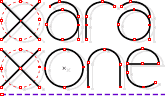|
|
|
Color space defines both the range and color capability of a design. Commonly, we use the RGB color space because to date, it most faithfully represents the gamut (range) of colors the human eye can perceive on-screen and to a lesser extent in the real world. When we see an image on-screen we think is photorealistic, the RGB color space is doing its job, accurately mimicking real world colors on-screen. However, thereís an uber color space within which RGB color space fits, and it was invented almost 100 years ago. The Commission Internationale de l'Eclairage (the CIE, the International Commission on Illumination) was established as a worldwide organ for standardizing and exchanging color specs. They are responsible for creating the LAB color model, one that successfully replicates the spectrum of human vision. Itís modeled after one channel of Luminance, one color channel that runs from magenta to green, and another channel from yellow to blue. LAB color is an important exchange space, because itís device-independent. In English, suppose youíre a soft drink company and you want your product colors to be identical when printed on metal, on plastic, on cardboard displays and on images on your Website. Different pigments react differently on different media, and by using LAB color specifications, youíre assured color consistency. Xara users donít have LAB to play with because colors assigned to vectors arenít calculated this way, but when you switch color modes and profiles (Iíll get to this in a minute) in Photoshop, LAB is used as an internal meeting place, so when you go from RGB to CMYK for example, no color space clipping occurs. Figure 1 shows a 3D representation of LAB color space.
|
|
The Xara Xone Guest Tutorials ©2005 Gary W. Priester All rights reserved
|


